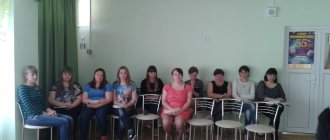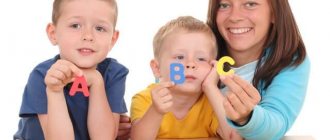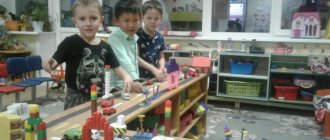Work experience “Workshop as a form of working with children”
In my report I would like to highlight this form of working with children as a workshop. Using this statement, I would like to emphasize the importance of developing creative activity in children as a factor in overall personal development and growth. The essence of the modern personality-oriented process of preschool education is the process of the child’s accumulation of such specific subjective experience, which contains means and ways of interacting with the world and thanks to this expands the child’s opportunities to actively and creatively participate in this interaction and, moreover, encourages him to acquire his own experience. Creativity in the broad sense of the word is an activity aimed at obtaining something new and unique. Therefore, the main indicator of creativity is the novelty of the created product. The result of children's creative activity, as a rule, is not distinguished by objective novelty that is significant for science, culture or production. However, the products of children's activities are new to themselves and play a huge role for the development of the child. The basis of any creativity is imagination. The preschool age of a child is characterized by activation of the functions of imagination. And if the imagination is not specifically developed during this period, then a rapid decrease in the activity of this function occurs subsequently. Along with a decrease in the ability to fantasize, a person’s ability to think creatively decreases. However, fantasy should contribute to a better knowledge of the world, self-discovery and self-improvement of the individual, and not develop into passive daydreaming. Domestic psychologists have identified indicators with the help of which children’s creativity is “recognized.” What determines the novelty of creative solutions? The novelty of creative solutions is facilitated by a broad orientation in the material before presenting any tasks, organized by an adult as an independent child experimentation that acquires a cognitive character, and the formation of generalized methods of activity encourages children to “embed” previously assigned methods into new semantic contexts. And this, in turn, leads to the generation of both new methods, new images and new meanings based on cognitive and emotional experience. What does children's creative activity contribute to? It contributes to the formation of a universal ability to construct any activity that is significant for a child, be it visual, speech, play, etc., as the creation of integrity (drawing, text, plot) from different units, but using the same techniques. “Creative workshops” are one of the modern forms of educational activities that are very attractive to children. Children love everything bright and unusual; they like to sculpt, draw, cut, stick, experiment, and design. And where else can a child realize his ideas, if not in the “workshop”? There is everything here to create. “Creative workshop” is one of the new forms of direct educational, joint and independent activity for children. Creative workshops can be used in various areas of children’s activities: for example, theater workshops, in which children can create their own costumes and attributes for performances, can be used to develop children’s communicative, aesthetic, and artistic abilities. Workshops on developing communicative abilities using problem situations and reading fiction can be used in speech development activities. Art workshops give children the opportunity to independently choose materials, direction and technique for making a craft or drawing. Workshops of good deeds will help organize work on repairing books, toys, labor education, for example, helping a junior teacher. A local history workshop will help familiarize children with the sights of their hometown, teach them to appreciate their small homeland and be a patriot. Educational workshops have the ability to create layouts and diagrams that will help children master natural knowledge, such as the basics of mathematics, chemistry, and learn about the world around them, its structure and patterns. Thus, the use of the workshop as a form of work with children is possible in a wide variety of activities; a significant advantage of this form of work is the voluntary nature of work in the workshop, the ability of children to be independent, to make choices, to develop empathy and the ability to build joint activities with peers. The work is built in stages, where each stage roughly corresponds to an age period, starting from the middle group. Within the stages, work is carried out cyclically: “Working with paper”, “Working with natural materials”, “Working with threads and fabric”. The mastered content of one cycle is integrated into other cycles. When planning material, the principle of concentricity is observed, i.e. at each stage the content increases and becomes more complex. For example: if in middle age, when working with natural materials (stones), children only examine and paint them in different colors, then in the older group they already decorate the stones, and in the preparatory group they bring them to life with the help of details. Classes in the “workshop” help children develop the basic skills and abilities provided for by the program: the ability to hold a pencil, use a brush, scissors; pick up paints, etc. and contributes to the implementation of the tasks provided for in the educational field of “Artistic and Aesthetic Development”. Creativity plays a special role, which is important at all stages of the workshop’s activities. The incentive for associative thinking plays an important role. Associations in the workshop are used to actualize the personal experience of the participants, develop the work of imagination and thereby contribute to the development of the creative process of everyone’s activity. Working with associations can be used in any type of workshop: this is one of the main technological methods for individualizing work, even with a large number of participants. The peculiarity of the “workshop” is that the children themselves decide whether to participate today or not. Creativity cannot exist under pressure and violence. It should be free, bright and unique. Without parting with pencils, felt-tip pens, and paints, the child quietly learns to observe, compare, think, and fantasize. Materials for joint activities in the form of a workshop can be very diverse: paint, paper, scissors, glue, colored pencils, felt-tip pens, different types of paper, brushes of different sizes and purposes, napkins, “waste” material: candy wrappers, threads, all kinds of scraps for cutting and stickers The creative process is a real miracle. This is confirmed by observations of how children reveal their unique abilities and the joy that creation gives them. Here they begin to feel the benefits of creativity and believe that mistakes are just steps towards achieving a goal, and not an obstacle, both in creativity and in all aspects of their lives. It is better to instill in children: “In creativity there is no right way, there is no wrong way, there is only your own way.”
Peacock made of plasticine and paper
If your child prefers to work with plasticine, invite him to sculpt a peacock:
- Make a circle and an oval from plasticine;
- Connect the round head and oval body;
- Fashion a triangular beak and attach to the head;
- Make a peacock crest from a cotton swab cut in half;
- Roll a piece of colored crepe paper into small balls;
- Cut out a semicircle from cardboard - the future tail of a peacock;
- Coat the semicircle with plasticine;
- Glue rows of paper balls in rows to form the peacock's tail.
Plasticine rose
- Roll long thin sausages from green plasticine, these will be the stems;
- Glue the stems to a piece of paper;
- Roll long, thin sausages from red, pink or yellow plasticine;
- Roll the sausage in a spiral to create a circle. These will be flowers;
- Attach flowers to stems;
- Make leaves from flat green ovals and add veins to them.
By the age of five, children have already mastered most of the techniques used in creating crafts, and the choice of product is limited only by the availability of the necessary materials at home.
Butterfly in palms
By the age of five, children are good at cutting out, especially large parts. With older children you can make a three-dimensional paper craft:
- Fold the A4 sheet in half;
- Place your palm on the fold and trace it with a pencil;
- Cut out the shape, you should have two palms joined together;
- Paint your palms;
- Cut out two butterflies from thick colored paper or cardboard, one of them should be slightly larger;
- Glue a large butterfly in the center of the palms. Apply glue only in the center so that the wings can rise;
- Glue a smaller butterfly on top;
- Fold the wings up so they stick out.



